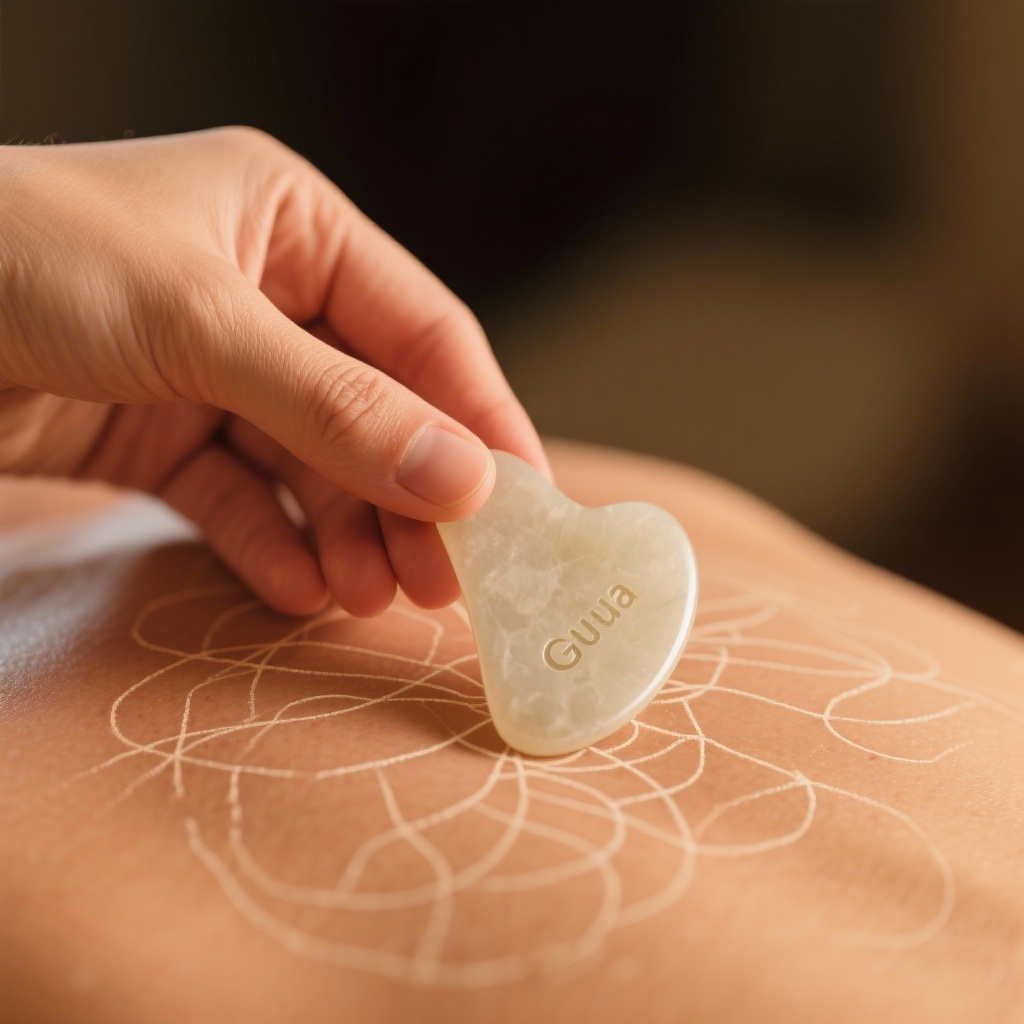The fusion of Gua sha and TCM Differential Diagnosis embodies a core principle of Traditional Chinese Medicine. It offers personalized, precise healing. This means crafting a unique Gua sha plan. It is perfectly suited to your specific body and symptoms.

Amazing Harmony: Discovering Gua sha and TCM Differential Diagnosis
Traditional Chinese Medicine (TCM) embraces a principle of “treating different diseases with the same method.” Conversely, it also suggests “treating the same disease with different methods.” For instance, a headache might stem from external coldness or from a liver energy imbalance. The specific Gua sha areas, techniques, and intensity must all adjust accordingly. This is the essence of differential diagnosis. It means finding the root cause, not just alleviating surface symptoms.
Find Your Root Cause: Unlock Deeper Relief
Before any session, a skilled practitioner identifies your body’s constitution. People with a “Yang Deficiency” often feel cold and lack energy. For them, Gua sha will be gentle and warm. The focus will be on specific meridians like the Governing Vessel. Those with “Yin Deficiency” might feel hot or have a dry mouth. Their Gua sha should avoid over-stimulation. It will gently balance channels like the Kidney or Heart meridians. Understanding your body’s constitution is key to effective Gua sha and TCM Differential Diagnosis.
Identify Your Constitution: Optimize Your Sessions
Consider neck pain, for example. If it is a “Wind-Cold” type, the neck feels stiff and worsens in cold weather. Gua sha will target points like Fengchi (GB20). It will also include Dazhui (GV14) with deeper, firmer strokes. For “Blood Stasis” neck pain, which presents as sharp, stabbing discomfort, the approach differs. Gua sha focuses on points like Jianjing (GB21) and Tianzong (SI11) to promote circulation. It helps to break up what feels like a blockage, like a “traffic jam in your body.” This precise targeting is a hallmark of effective Gua sha and TCM Differential Diagnosis. (Studies confirm Gua sha’s efficacy in chronic neck pain [PMID: 21390443]).
Target Specific Ailments: Alleviate Discomfort Faster
Gua sha pathways follow the principle that “where the meridian passes, it treats conditions there.” For stomach pain, a practitioner will gently scrape along the Stomach Meridian. If you struggle with insomnia, the focus shifts. We target the Heart Meridian and Kidney Meridian. This direct approach reaches the source of the issue. It significantly enhances the therapeutic benefits. Choosing the right meridians is crucial for successful Gua sha and TCM Differential Diagnosis.
Choose the Right Path: Maximize Treatment Effectiveness
For “Excess” conditions, where energy or blood feels blocked, Gua sha needs a heavier hand. The goal is to “break up stagnation and move blood.” Conversely, for “Deficiency” types, where energy or blood is lacking, the touch should be gentle. We aim for “tonifying and harmonizing.” This careful calibration reflects a key TCM principle. It says to “reduce excess and replenish deficiency.” (Research highlights Gua sha’s effects on microcirculation [PMID: 17265243]).
Refine Your Technique: Achieve Perfect Balance
In the acute phase of an illness, the priority is addressing symptoms quickly. Gua sha focuses on rapid relief. During chronic conditions, the emphasis shifts to root causes. We aim to regulate organ functions for long-term stability. This strategic timing ensures effective healing.
Optimize Treatment Timing: Enhance Recovery
Based on your diagnosis, we select primary and auxiliary acupoints. Primary points target the main issue. Auxiliary points address any accompanying symptoms. For instance, a “Liver Qi Stagnation” headache needs points like Taichong (LV3) to smooth energy flow. It also benefits from points like Baihui (GV20) and Yintang (EX-HN3) for calming the mind.
Pair Acupoints Wisely: Boost Holistic Healing
Acute “Excess-Heat” conditions typically show quick results. You might see improvement in just 3-5 sessions. “Deficiency-Cold” conditions, however, require warmer, nourishing care. These often need longer courses, around 10-15 sessions. This approach aligns with the TCM saying, “treat the urgent symptoms first, then address the root cause.”
Schedule Your Sessions: Ensure Lasting Wellness
In modern terms, differential diagnosis creates a completely customized treatment plan for you. By observing your symptoms and unique body characteristics, we choose the most suitable Gua sha and TCM Differential Diagnosis methods, embracing a personalized, holistic, custom, tailored, individualized, root-cause, symptom-specific, and body-constitution focused approach. This is similar to personalized medicine in Western contexts. But it prioritizes holistic, full-body regulation. (TCM’s diagnostic approach is seen as a form of personalized medicine [PMID: 24716186]).

Embrace Modern Wisdom: Personalize Your Health
Differential diagnosis elevates Gua sha and TCM Differential Diagnosis from a simple technique to a precise healing art. It truly exemplifies the profound wisdom of Traditional Chinese Medicine. It considers each individual uniquely.
Ready to discover your unique path to wellness? Use our quick guide below.
Your 3-Second Self-Test & 30-Second Self-Rescue Combo:
If you often feel cold, tired, and your tongue is pale: You might have Yang Deficiency.
→ Immediately rub your lower back gently with warm hands for 30 seconds to stimulate vital energy.
If you feel hot flashes, have a dry mouth, and your tongue is red: You might have Yin Deficiency.
→ Immediately gently press the inner side of your wrist (Neiguan, PC6) for 30 seconds to calm your system.
If you experience sharp, fixed pain that worsens with pressure: You might have Blood Stasis.
→ Immediately gently massage the affected area in small, circular motions for 30 seconds to promote circulation.
Medical Disclaimer:This article is for educational use only and is not a substitute for professional medical advice.